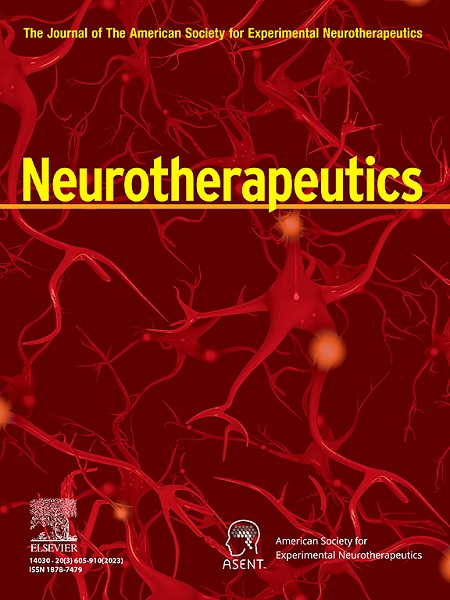Δ9-四氢大麻酚和大麻二酚的组合可调节阿尔茨海默病动物模型海马中谷氨酸的动态变化。
IF 5.6
2区 医学
Q1 CLINICAL NEUROLOGY
引用次数: 0
摘要
以前曾有研究表明,非精神活性剂量的Δ9-四氢大麻酚(Δ9-THC)和大麻二酚(CBD)组合可减轻阿尔茨海默病(AD)动物模型 APP/PS1 小鼠的认知能力下降。然而,Δ9-THC 和 CBD 治疗特性的神经生物学基础尚未完全清楚。考虑到谷氨酸能活动失调是导致阿尔茨海默病认知障碍的原因之一,本研究评估了这两种天然大麻素的组合可能逆转这种阿尔茨海默病动物模型海马内谷氨酸动态变化的假设。有趣的是,我们的研究结果表明,长期使用Δ9-THC 和 CBD(而不是单独使用其中任何一种)可以降低 APP/PS1 小鼠的细胞外谷氨酸水平和海马的基础兴奋性。这些影响与谷氨酸突触功能和结构的显著变化无关,因为在大麻素处理的小鼠身上没有观察到突触可塑性、谷氨酸信号转导或这些突触关键成分水平的相关变化。相反,我们的数据表明,这些大麻素效应与谷氨酸摄取的控制和/或海马网络的调节有关。综上所述,这些结果支持将这些天然大麻素结合在一起以对抗发生在 AD 大脑中的兴奋毒性的潜在治疗特性。本文章由计算机程序翻译,如有差异,请以英文原文为准。
A combination of Δ9-tetrahydrocannabinol and cannabidiol modulates glutamate dynamics in the hippocampus of an animal model of Alzheimer's disease
A combination of Δ9-tetrahydrocannabinol (Δ9-THC) and cannabidiol (CBD) at non-psychoactive doses was previously demonstrated to reduce cognitive decline in APP/PS1 mice, an animal model of Alzheimer's disease (AD). However, the neurobiological substrates underlying these therapeutic properties of Δ9-THC and CBD are not fully understood. Considering that dysregulation of glutamatergic activity contributes to cognitive impairment in AD, the present study evaluates the hypothesis that the combination of these two natural cannabinoids might reverse the alterations in glutamate dynamics within the hippocampus of this animal model of AD. Interestingly, our findings reveal that chronic treatment with Δ9-THC and CBD, but not with any of them alone, reduces extracellular glutamate levels and the basal excitability of the hippocampus in APP/PS1 mice. These effects are not related to significant changes in the function and structure of glutamate synapses, as no relevant changes in synaptic plasticity, glutamate signaling or in the levels of key components of these synapses were observed in cannabinoid-treated mice. Our data instead indicate that these cannabinoid effects are associated with the control of glutamate uptake and/or to the regulation of the hippocampal network. Taken together, these results support the potential therapeutic properties of combining these natural cannabinoids against the excitotoxicity that occurs in AD brains.
求助全文
通过发布文献求助,成功后即可免费获取论文全文。
去求助
来源期刊

Neurotherapeutics
医学-神经科学
CiteScore
11.00
自引率
3.50%
发文量
154
审稿时长
6-12 weeks
期刊介绍:
Neurotherapeutics® is the journal of the American Society for Experimental Neurotherapeutics (ASENT). Each issue provides critical reviews of an important topic relating to the treatment of neurological disorders written by international authorities.
The Journal also publishes original research articles in translational neuroscience including descriptions of cutting edge therapies that cross disciplinary lines and represent important contributions to neurotherapeutics for medical practitioners and other researchers in the field.
Neurotherapeutics ® delivers a multidisciplinary perspective on the frontiers of translational neuroscience, provides perspectives on current research and practice, and covers social and ethical as well as scientific issues.
 求助内容:
求助内容: 应助结果提醒方式:
应助结果提醒方式:


